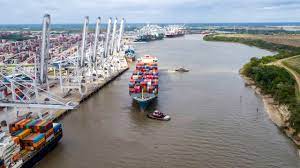
Projected growth at the Port of Savannah is driving the need for major highway improvements.
ATLANTA – It’s going to cost at least $1.4 billion – and probably a lot more – in highway improvements in the Savannah region to keep pace with economic growth, an official with the Georgia Department of Transportation said Wednesday.
“It’s a good problem to have,” Matt Markham, the agency’s deputy planning director, told members of the State Transportation Board’s Strategic Planning Committee. “It’s a sign of an economy that’s growing.”
Markham outlined the findings of a study of current conditions and future needs of major highway corridors in four of the region’s counties: Chatham, Bryan, Effingham, and Bulloch.
To no one’s surprise who lives and/or works in the area, the study found that Georgia 21 is a major bottleneck, more connections are needed between Georgia 21 and Interstate 16, and U.S. 80 doesn’t have enough capacity.
Traffic flow in the Savanah area is particularly critical to the Port of Savannah, a major economic driver for the region.
With the projected growth in its containerized cargo business, the port’s capacity is expected to increase 60% by 2025. Already, 75% of commercial truck trips in the four counties are into and out of the Port of Savannah, Markham said.
Without major improvements, travel times will only continue to worsen, he said.
The study recommends spending about $1.4 billion on improvements to 12 major highway corridors, including Georgia 21, U.S. 80, interstates 16 and 95, and Effingham Parkway. Together, building those projects would bring 36% more of the region’s industrial space within one hour of the port and reduce traffic delays in the four counties by 58%, Markham said.
The problem is the $1.4 billion planning estimate is in 2022 dollars, and the projects the study contemplates are aimed at addressing traffic congestion through 2050.
Several board members wondered where the funding is going to come from to pay for the work.
Markham conceded funding sources for such a list of projects have yet to be identified. But he said having the study available will make the Georgia Department of Transportation more prepared when funding opportunities including federal grants come along.
In related business Wednesday, Andrew Hoenig, the DOT’s construction program manager, told board members construction is expected to begin in the spring of 2025 on a project to replace the cables on the Talmadge Bridge in Savannah and potentially raise the structure to more easily accommodate cargo ships calling at the Port of Savannah.
The work will be done without closing the bridge to traffic, at an estimated cost of $150 million to $175 million.
“This is a much more efficient cost than replacing the whole bridge,” Hoenig said.
The project will be the first the state has built using the Construction Management/General Contractor (CM/GC) model of contracting. Unlike contracts the DOT normally undertakes, the CM/GC model gets the contractor involved as the project is being designed.
While some bridge projects across the nation have involved replacing cables, combining the cable work with raising the bridge would be a first, Hoenig said.
The project, which will be federally funded, is expected to take two-and-a-half to three years to complete.
